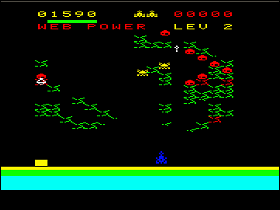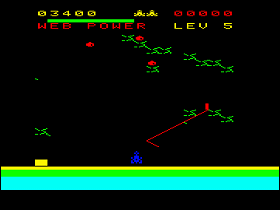 The Game: Spiders slink down from the top of the screen, constructing an elaborate web and laying eggs as they go. The player, manning a mobile bug-blasting cannon, can take out the spiders, but the eggs are still gestating and will hatch new spiders unless they’re destroyed; new spiders repeat the cycle in rapid succession. Spiders will manage to build their web to the bottom of the screen, restricting the cannon’s movement (and creating zones of the screen where future spider hatchlings can move unimpeded). The game ends when the player loses all of the cannons to the spiders or their incoming fire. (Emerson, 1982)
The Game: Spiders slink down from the top of the screen, constructing an elaborate web and laying eggs as they go. The player, manning a mobile bug-blasting cannon, can take out the spiders, but the eggs are still gestating and will hatch new spiders unless they’re destroyed; new spiders repeat the cycle in rapid succession. Spiders will manage to build their web to the bottom of the screen, restricting the cannon’s movement (and creating zones of the screen where future spider hatchlings can move unimpeded). The game ends when the player loses all of the cannons to the spiders or their incoming fire. (Emerson, 1982)
Memories: In this early epoch of the video game industry, there seemed to be a perception that you simply weren’t taking things seriously unless you secured an arcade license. Witness the Odyssey2, whose sole first-party licensed arcade port came too late in the machine’s library to bolster its popularity, or the Intellivision, which avoided arcade ports at first and then broke through to widespread popularity with a licensed home version of Burgertime.
 Not wanting to be a casualty of the video game wars, Emerson landed a handful of relatively obscure arcade licenses such as Jungler, Funky Fish and Spiders – none of them exactly household names in the coin-op world. (Most people probably can’t even remember seeing these games in the arcade at all; the author of this review barely remembers seeing Spiders and Jungler in the flesh.) Spiders was actually this vague and abstract in the arcade, too, so it’s really not a bad port, especially on the Arcadia 2001.
Not wanting to be a casualty of the video game wars, Emerson landed a handful of relatively obscure arcade licenses such as Jungler, Funky Fish and Spiders – none of them exactly household names in the coin-op world. (Most people probably can’t even remember seeing these games in the arcade at all; the author of this review barely remembers seeing Spiders and Jungler in the flesh.) Spiders was actually this vague and abstract in the arcade, too, so it’s really not a bad port, especially on the Arcadia 2001.
 For such an obscure arcade game, Spiders got around; there was also a fairly entertaining Entex tabletop game, though its matrix of fixed graphics made it much more difficult to figure out what was going on. The Arcadia version is fairly faithful to the original, duplicating the utter strangeness of the coin-op original nicely.
For such an obscure arcade game, Spiders got around; there was also a fairly entertaining Entex tabletop game, though its matrix of fixed graphics made it much more difficult to figure out what was going on. The Arcadia version is fairly faithful to the original, duplicating the utter strangeness of the coin-op original nicely.